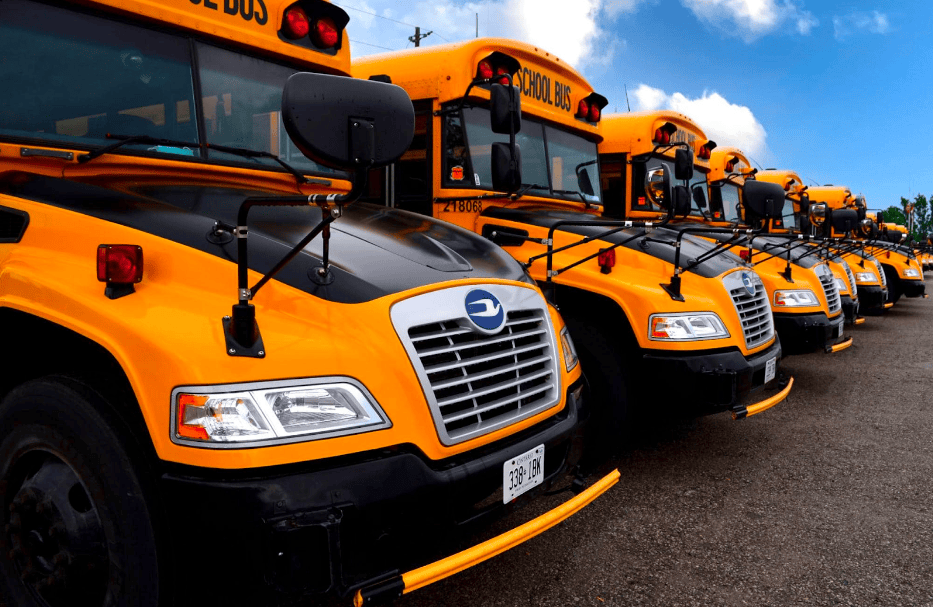Have you ever wondered why parking lot discussions become a hot topic at school board meetings? It’s more than just heated discussions about time, money, and asphalt.
Let’s dive into the parking requirements for schools to see how to make an efficient, accessible, and safe school parking lot.
How Much Parking Do Schools Really Need?

The size and availability of parking spaces at schools directly impact the daily lives of students, staff, and visitors.
Adequate parking ensures that everyone’s day starts off right by avoiding unnecessary stress from searching for a spot. Inadequate parking can cause tardiness, which could result in disciplinary action for students and staff members. Plus, when schools host events like sports games and parent-teacher conferences, those parking lots might require extra space or additional members to facilitate traffic.
In fact, a good parking lot doesn’t just meet the parking requirements for schools but also goes beyond convenience, which is why schools need well-designed, safe parking lots to accommodate all vehicles while ensuring smooth traffic flow.
This balance prevents congestion, reduces the risk of accidents, and ensures quick access to emergency vehicles.
6 Parking Requirements for School Parking Lots

What are the parking requirements for schools? Here are 6 considerations all schools must make when designing their parking lot:
1. Enough Parking Spaces
Ensuring sufficient parking spaces is fundamental. Schools must cater to the needs of teachers, students, and visitors, with additional capacity for special events.
Underestimating this need can lead to off-site parking issues and neighborhood congestion that results in unnecessary tardiness and undeserved disciplinary action.
2. Access Aisles
Access aisles are vital for a seamless flow of traffic within the parking lot. They facilitate smooth entry and exit from parking spaces by reducing bottlenecks and improving safety. Properly designed aisles can also accommodate emergency and maintenance vehicles for comprehensive accessibility.
3. Space Size Requirements
Parking space sizes are also a crucial component of the parking requirements for schools. Car-accessible spaces need a width of at least 96 inches and an access aisle of 60 inches. These spaces should have a gentle slope, a firm, slip-resistant surface, and clear signage.
Van accessible spaces, offering wider or additional access aisles and higher clearance, must adhere to similar standards. These accommodations ensure inclusivity and compliance with accessibility laws, which ultimately help make school parking lots safer and more accessible.
4. Accessible Parking
Accessible parking, sometimes called disabled parking, is not just a requirement;it is a legal requirement for all parking lots, including the parking requirements for schools.
These spaces must be strategically located to offer the shortest route to the building entrance so that individuals with disabilities have equal access to school facilities.
5. Affordability
Cost-effectiveness plays a crucial role in selecting parking solutions, especially when it comes to public school systems. Schools on a shoestring budget must find a balance between initial installation costs and long-term maintenance. Affordable parking solutions can free up funds for other educational purposes.
6. Parking Blocks
Parking blocks are essential for organizing spaces and ensuring vehicles park correctly. They also play a role in pedestrian safety by marking clear walking paths separate from driving lanes.
The Best Materials to Meet Parking Requirements for Schools

Selecting the right material is key to a functional and durable parking lot that meets the parking requirements.
But with so many materials available, how are schools supposed to choose the right one? Let’s break it down:
Concrete
Concrete is a super popular parking lot material option. It’s incredibly durable but can be expensive and prone to cracking over time. It requires significant maintenance to address wear and tear from heavy usage, so it might not be the best option available for school parking lots.
Asphalt
Asphalt offers a smoother surface but heats up quickly and can deteriorate under extreme weather conditions. Regular maintenance is also needed to fill cracks and reseal the surface. So, while this is another popular option, it might not be the best option for school parking lots.
Loose Gravel
Loose gravel is affordable but not the safest choice. It can shift to create uneven surfaces and pose tripping hazards. It’s also challenging for snow removal and can clog storm drains. If you’re looking at material options for school parking lots, this should be the last option on your list.
Permeable Pavers
Permeable pavers are an eco-friendly and durable material option that is absolutely perfect to help schools meet parking requirements. Here are a few key benefits that make permeable paver systems better than the rest:
Reduced Runoff
Parking minimums can impact stormwater runoff by creating more impermeable surfaces. Permeable paving can be used to meet the parking minimum without affecting the impervious cover limits.
Combined Use
Permeable paving can be used as an underground stormwater detention and drainage system as well as a surface for parking. By combining these functions, the school and community can reduce land use, safe space, and safe money.
Eco-Friendly
Permeable pavers allow rainwater to filter through the ground beneath the parking lot, reducing the amount of runoff that would otherwise flow into and pollute local waterways.
Reduces Urban Heat Island Effect
Traditional asphalt and concrete surfaces absorb and retain heat which contributes to higher temperatures in urban areas. Permeable pavers, on the other hand, have a lighter color and less heat absorption, which helps reduce the urban heat island effect.
Durability and Strength
Designed to withstand heavy loads, permeable pavers are highly durable. They can support the weight of many types of vehicles which makes them suitable for high-traffic areas such as school parking lots. The interlocking design disperses the load evenly to significantly reduce the likelihood of cracks and potholes.
Low Maintenance
Unlike asphalt or concrete surfaces that require regular sealing and repairs, permeable pavers require minimal maintenance.
Improved Safety
The porous nature of permeable pavers ensures quick rainwater drainage to reduce puddles and slippery surfaces. Additionally, with all the stormwater detention safely done within the permeable paving cross-section, this can eliminate the need for dangerous, open detention ponds that can be hazardous to human health and can be a potential hazard.
LEED Certification
Schools aiming for sustainability and green building certifications, such as LEED (Leadership in Energy and Environmental Design), can earn points by utilizing permeable pavers.
Meet Parking Requirements for Schools with Permeable Pavers

Choosing permeable pavers for a school parking lot isn’t just an upgrade, it’s a long-term investment in safety, sustainability, and functionality.
TRUEGRID® Permeable Pavers are a solution that ticks all the boxes when it comes to the parking requirements for schools. TRUEGRID can handle all of the functions of stormwater detention and parking surfacing, all in one. Their durability, affordability, and eco-friendliness make them the best choice for any educational institution looking to improve its infrastructure.
Ready to transform your school’s parking lot? Contact our team today!



